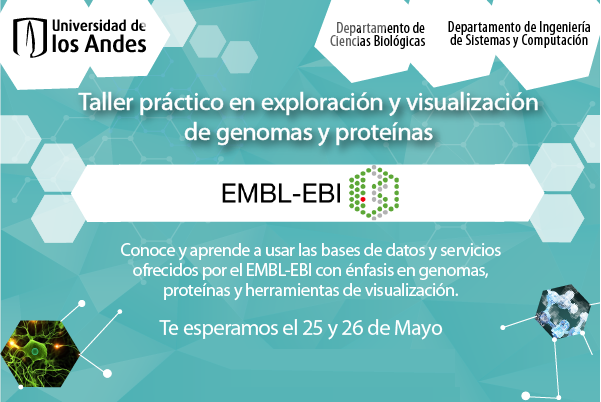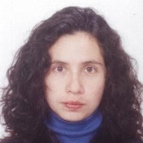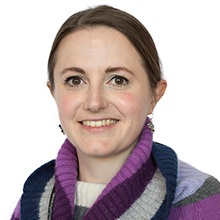La parte de genomas y de proteínas se centrará en especies como humano, pez cebra, aspergillus nidulans y zea mays, mientras que la parte de visualización cubrirá principalmente el uso de componentes web.
Este taller será dictado por Emily Perry y Leyla Jael García, investigadoras del European Bioinformatics Institute (EMBL-EBI).

Fecha:
25 y 26 de mayo del 2015
Hora:
9:00 A.M a 5:00 P.M
Lugar:
Universidad de los Andes - Edificio Mario Laserna, salón ML 516
Agenda 25 de Mayo
Actividad: Introducción a EMBL-EBI
Hora:
9:00 a.m. - 9:45 a.m.
Descripción:
Visión general de los principales recursos ofrecidos por el EMBL-EBI incluyendo bases de datos y herramientas de análisis.
Objetivos de aprendizaje:
- Entender qué es el EMBL-EBI y conocer las bases de datos y herramientas que ofrece
Responsable:

Leyla Jael García
Actividad:Introducción a UniProt
Hora:
10:00 a.m. - 12:00 m.
Descripción:
Guía de acceso a UniProt (proteínas y proteomas), incluyendo el tipo de informacion provista y el acceso a la misma a través del sitio web. Uso de herramientas para comparación de proteínas (blast). Concimiento básico en biología y proteínas es requerido.
Objetivos de aprendizaje:
- Conocer la información que UniProt provee y el potencial que ofrece
- Explorar la información ofrecida por UniProt y entender de dónde viene
- Realizar búsquedas básicas y avanzadas en el sitio web de UniProt
- Utilizar el sitio web de UniProt para obtener información sobre proteomas
- Utilizar el sitio web de UniProt para obtener información sobre variaciones y enfermedades
- Conocer las diferentes alternativas de descarga
- Conocer las diferentes alternativas de acceso programático a UniProt incluyendo servicios REST, java, y RDF (si el tiempo lo permite)
Responsable:

Leyla Jael García
Actividad: Introducción a European Nucleotide Archive e Introducción a Ensembl
Hora:
1:00 p.m. - 5:00 p.m.
Descripción:
Vista rápida sobre cómo buscar y obtener secuencias de nucelótidos de ENA. Entendimiento básico de secuencias de nucleótidos y conceptos como gen, exon y mRNA es requerido.
Objetivos de aprendizaje:
- Entender qué es ENA y de dónde viene la información
- Utilizar el navegador de ENA y el portal taxonómico
- Realizar búsquedas en ENA a partir de texto y secuencias
Responsable:

Emily Perry
Agenda 26 de Mayo
Actividad: Introducción a BioJS
Hora:
9:00 a.m. - 10:00 a.m.
Descripción:
Introducción al proyecto de visualización y manipulacion de datos biológiocos en Javascript
Objetivos de aprendizaje:
- Conocer qué es BioJS y cuáles son sus prinicipios
- Entender cómo utilizar e integrar componentes BioJS
- Conocer los prinicipios de desarrollo de componentes BioJS mediante un ejemplo práctico
Responsable:

Leyla Jael García
Actividad: Introducción a Ensembl y Ensembl Genome Browser
Descripción:
Experiencia práctica sobre el uso del navegador de Ensembl. Ensembl provee acceso a genomas en humanos, ratones, pez cebra y otros en su mayoría vertebrado, alrededor de 80 especies están incluídas. También incluye algunas plantas, fungi, metazoarios, protozoarios y bacteria (los organismos usados en el taller, 2 ó 3, deben ser escogidos con anterioridad)
Hora:
10:15 a.m. - 12:00 m.
Objetivos de aprendizaje:
- Visualizar genes
- Utilizar a nivel básico BioMart, una herramienta de minería de datos
Responsable:

Emily Perry
Hora:
1:00 p.m. - 3:00 p.m.
y
3:15 p.m. - 4:45 p.m.
Objetivos de aprendizaje:
- Dos de los siguientes temas:
- Visualizar SNPs, otras variaciones sobre la secuencia y fenotipos asociados
- Realizar comparaciones mutli-especies
- Identificar secuencias potencialmente involucradas en regulación genética (por ejemplo ENCODE y projectos epigenéticos --únicamente si hay interés en el genoma humano)
- Utilizar datos propios (e.g., archivos BAM, BigWig y VCF) y desplegarlos en el navegador
Responsable:

Emily Perry
Actividad: Cierre
Hora:
4:45 p.m. - 5:00 p.m.
Leyla Jael García Castro

She is a software developer with interests in Web Development, Semantic Web and Bioinformatics. She currently works at the European Bioinformatics Institute (EMBLEBI) as a Software Developer in the UniProt team. She currently focuses on projects related to protein visualization and linked data. She is one of the founders of the BioJS initiative, a community project for biological data visualization and manipulation in JavaScript. She has participated as facilitator in workshops and tutorials for both UniProt and BioJS, as well as mentor for the Google Summer of Code 2014; she also worked as a lecturer in Colombia for about 10 years.
Education
- 2006 MSc in Computer Science, University of Los Andes, Bogota, Colombia. Concentration: Software Engineering and Geographical Information Systems
- 2004 Specialization on Education, University of the Army Forces Nueva Granada, Bogota, Colombia. Concentration: Information and communication technologies for learning purposes in universities
- 1997 BSc in Computer Science, University of Los Andes, Bogota, Colombia. Concentration: Software and Data Bases Development
Dr. Emily Perry

For the past 2.5 years I have worked as an Outreach Officer for Ensembl, being promoted to Outreach Project Leader in February 2015. I have a PhD in Molecular Biology and have worked in Science Communication.
Education
- 2007-2011 PhD with Professor Wendy Bickmore, MRC Human Genetics Unit, University of Edinburgh: Chromatin Condensation in Cornelia de Lange Syndrome. My thesis looked at a genetic disorder, Cornelia de Lange Syndrome, known to be caused by mutations in the cohesin complex and its loader, NIPBL, which are known to complex with CTCF to organise chromatin into 3D structures. I investigated the effects on chromatin compaction in cells from Cornelia de Lange patients and cells treated with RNAi to knock-down cohesin, NIPBL and CTCF expression.
- 2006-2007 MSc by Research in the Life Sciences, MRC Human Genetics Unit, University of Edinburgh. The course consisted of three lab projects over the course of a year: modelling cardio-facial cutaneous syndrome in zebrafish with Dr Liz Patton, assaying the response to diphtheria toxin of DPH1- cells with Dr Ian Jackson and chromatin condensation in Cornelia de Lange Syndrome with Professor Wendy Bickmore. The last of which I continued on for my PhD.
- 2002-2006 BSc Honours (2.I) in Biological Sciences (Genetics), University of Edinburgh. The course covered Biological Sciences from a broad perspective in the first three years, with specialisation in the fourth year and a lab project looking at bacteriophage DNA mimicry in by the OCR protein to evade bacterial defence mechanisms with Dr David Dryden.



